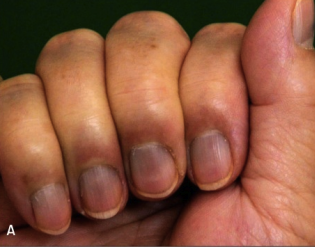Our bodies have hundreds of small, often subtle ways to send us messages about our health. Things like the color of our skin, how much our hair falls out, how quickly wounds heal, and acne can all signal nutrient status, the state of our microbiome, potential food intolerances, and even serious diseases such as diabetes or cancer.
One area of our bodies that most of us have probably never given a second thought of, however, can actually provide you with plenty of valuable information about your health: The white half-moon on your fingernails, the lunula. (1, 2)
What Is Lunula?

The lunula, while it looks like it is part of your nail, actually sits on top of the skin just underneath your nail. It is a protective covering of the otherwise vulnerable blood vessels found there. Everyone has a lunula, though it is not always visible on all fingers (many can only really see it on their thumbs). The lunula plays a large role in the shape of your fingernails and how they grow, any damage to it can forever change how your nail grows, if at all. (1, 2)
What does you lunula mean for your health?
According to a study published in the 1996 Journal of the Academy of Dermatology, the lunula has three ways it warns you of potential health problems: Through it’s size, shape, and color. A normal, healthy lunula is half-moon shaped, ivory, and takes up about a 5th of your nail. If you notice any of the following changes to your lunula, you may want to make an appointment with your doctor or health care practitioner. (1, 2)
Lunula Size
As mentioned already, your lunula should be roughly a fifth of your nail. Any bigger or smaller and it could mean trouble: (1, 2)
Macrolunula: This is when the lunula is bigger or enlarged. For some ethnicities, particularly those of Indian decent, this is normal. Otherwise, it can signify endocrine disorders such as hyperthyroidism. (1, 2)

Microlunula and anolunula: This is when the lunula is either small or absent all-together. While a microlunula is usually normal for people of African descent and can simply be age-related, it can also signify other problems, such as: (1, 2)
- Cardiovascular atherosclerosis (hardening of the arteries) (2)
- Chromosomal diseases (2)
- Nail diseases (2)
- Endocrine disorders, including both hypo- and hyperthyroidism (2)
- Iron Deficiency Anemia and malnutrition (2)
- HIV (2)
- Nerve injury (2)
- Renal failure (2)
- Rheumatoid Arthritis (2)

Lunula Shape

The lunula effects the way your nail grows, so if its shape is off, chances are you will grow nails that are also mishapen. When something is wrong, the lunula can change from its regular half-moon shape to more square or even triangular. (1, 2) There can be many reasons your lunula changes shape:
- Osteo-onychodysplasia, also known as Nail-Patella Syndrome, which can result in several deformities, pain and discomfort. It is usually hereditary. (2, 3)
- Trisomy: Chromisomal disorders, including Down Syndrome, Edward Syndrome, and Patau Syndrome (2, 4)
- Nail trauma (2)
Lunula Color

Also known as lunar dyschromia, the lunula should be more ivory in color, though it is common for those with dark skin tone to have a blue-ish tinge to theirs. If your lunula is any of the following colors, make sure to go check with your doctor to make sure you don’t have or are at greater risk for any of their associated illnesses. (1, 2)
- Red Spots: A red spotted lunula could mean alopecia, areata, vitiligo, or psoriasis. It could also signify nail dystrophys and deformity diseases. (1, 2)
- Blue: This is often caused by systematic drug ingestion, including Exlax, chemotherapy drugs, and other cancer and HIV drugs. A blue lunula has also been connected with Wilson’s disease and Hemoglobin M disease. (1, 2)
- Yellow: Yellow lunulas are most often caused by exposure to insecticides and pesticides. (1, 2)
- White: While your lunula should appear whiter than the rest of your nail, extremely white lunulas can mean trouble. Also known as Leukonychia, this is often seen in those with chronic renal failure, nephrotic syndrome, cirrhosis, congestive heart failure, and diabetes. (1, 2, 5)

The Bottom Line
So, what is lunula? Now you know and as you can see, your nails provide valuable information about your health. If you notice that your lunula has any of the above characteristics, don’t panic. Check in to see if you have any other symptoms of any of the mentioned diseases, and make an appointment with your doctor to talk about your concerns and have a check-up.
Be sure to share this article with your friends and family so they, too, can have a more complete understanding of what their nails are trying to tell them about their health.

Sources
- Cohen, P. R. (1996, June). The lunula. Retrieved August 09, 2017, from https://www.ncbi.nlm.nih.gov/pubmed/8647987
- Cohen, P. R., MD. (1996). The Lunula. The Journal of the Academy of Dermatology,34(6), 943-953. Retrieved August 09, 2017.
- Love, W. H., & Beiler, D. D. (n.d.). Osteo-onychodysplasia. : JBJS. Retrieved August 09, 2017, from https://journals.lww.com/jbjsjournal/Abstract/1957/39030/Osteo_onychodysplasia_.18.aspx
- Trisomy Disorders. (2013). Retrieved August 9, 2017, from https://www.betterhealth.vic.gov.au/health/conditionsandtreatments/trisomy-disorders
- Leukonychia in Adult. (n.d.). Retrieved August 09, 2017, from https://www.visualdx.com/visualdx/diagnosis/leukonychia?moduleId=101&diagnosisId=51852

